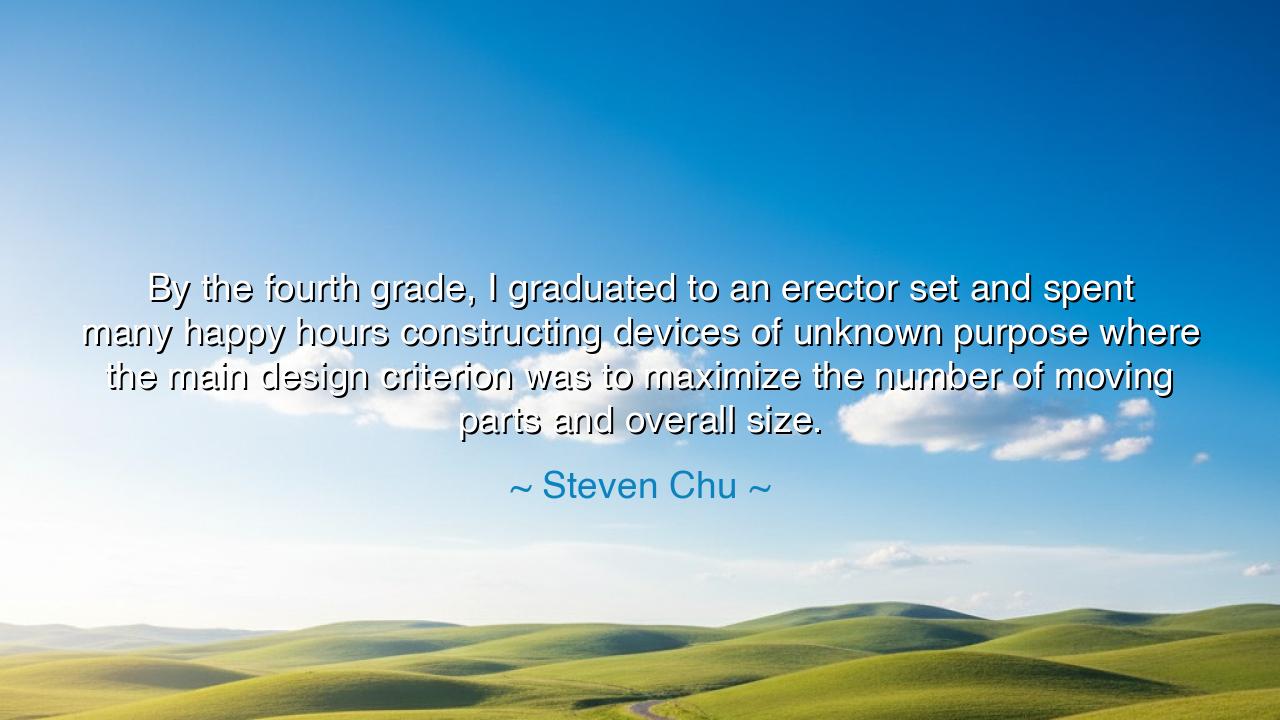
By the fourth grade, I graduated to an erector set and spent many
By the fourth grade, I graduated to an erector set and spent many happy hours constructing devices of unknown purpose where the main design criterion was to maximize the number of moving parts and overall size.






The words of Steven Chu—“By the fourth grade, I graduated to an erector set and spent many happy hours constructing devices of unknown purpose where the main design criterion was to maximize the number of moving parts and overall size”—speak to the divine spark of curiosity that dwells within the human soul. In these humble words, uttered by a future Nobel laureate, we glimpse the beginning of wisdom: not the pursuit of profit or recognition, but the pure joy of creation for its own sake. Chu, long before he became a physicist, was a child enchanted by movement, form, and possibility. His “devices of unknown purpose” were not useless—they were the first steps of a mind learning to dream through design.
To build without knowing the end is a sacred act. It is to explore for the sake of wonder, to move beyond the narrow boundaries of reason and into the vast field of imagination. The child who builds, not to impress but to discover, mirrors the gods of old who shaped the cosmos from chaos, guided not by instruction, but by instinct and joy. Chu’s erector set—simple rods and gears—became his temple, his laboratory, his teacher. Through it, he learned one of the greatest lessons of life: that creation itself is the purpose. The “unknown purpose” of his early inventions foreshadowed the essence of science itself—the endless seeking, the daring to make, to test, to fail, and to begin again.
The origin of this quote lies in the early life of a boy who would one day stand among the world’s great scientists. Steven Chu, who would go on to win the Nobel Prize in Physics and serve as U.S. Secretary of Energy, never lost the playful curiosity that first drew him to his erector set. That childhood fascination with motion and mechanism became the foundation for a lifetime of exploration. His youthful delight in “maximizing moving parts” was the spark that lit the fire of inquiry—the same fire that has driven human progress since the dawn of time. From that playful beginning came a life devoted to unlocking the mysteries of light and matter, proving that even the greatest discoveries begin not with certainty, but with wonder.
The ancients would have understood this well. For they, too, revered curiosity as a divine impulse. Consider the story of Archimedes, the Greek mathematician who, while bathing, noticed the water rise as he entered the tub. In that simple moment of play, of idle observation, he discovered the law of buoyancy—a revelation that changed science forever. Like the child with his erector set, Archimedes did not begin with purpose but with fascination. His famous cry, “Eureka!” was not the shout of a man who found what he sought, but of one who had found more than he ever expected. In this way, Chu and Archimedes share a sacred kinship—the joy of discovery born from play.
Chu’s words also remind us of the innocence of creation. As adults, we are too often enslaved by utility. We ask of every act, “What is its purpose? What will it yield?” But the child asks instead, “What will it become?” The wise know that many of the world’s greatest inventions were born from experiments that began without clear intention. The Wright brothers, tinkering with gliders, were not trying to change the world—they were chasing the thrill of flight. The same spirit guided Chu in his youth: to make things move, to watch them come alive, to learn by touching mystery. In this, we see the seed of all innovation—the courage to explore without needing to know why.
There is also humility in Chu’s reflection. He does not glorify his early work as genius, but as joy. The young builder was not a prodigy but a wanderer, guided by fascination rather than foresight. In a world obsessed with results, his words are a reminder that true mastery grows not from ambition, but from love. The one who builds out of love for building, who learns out of love for learning, who creates without fear of failure—such a one becomes, in time, a master. This is why the ancients said that the craftsman’s hand is an extension of his heart, and his creation a mirror of his soul.
Let this, then, be the lesson: nurture curiosity, for it is the wellspring of all greatness. Build, explore, imagine—not because you must, but because you may. Do not wait for permission or purpose to guide you. Begin, as Steven Chu began, by finding joy in the movement of things—in the simple wonder of what can be made with your hands and your mind. The devices you build may serve no clear end today, but through them you will learn to think, to question, to see the world anew. And one day, as with Chu, those “devices of unknown purpose” may become the foundation upon which you change the world.
For in the end, the heart that builds without reason builds with love, and love is the source of all wisdom. The ancients would have said: play is the first act of creation, curiosity the mother of invention, and joy the father of mastery. So go forth and create—not to prove, but to discover; not to finish, but to begin again. In the dance of your ideas, in the rhythm of your imagination, you will find what all true builders find: that life itself is the greatest erector set, and the hands that shape it belong to those who dare to dream with motion.






AAdministratorAdministrator
Welcome, honored guests. Please leave a comment, we will respond soon